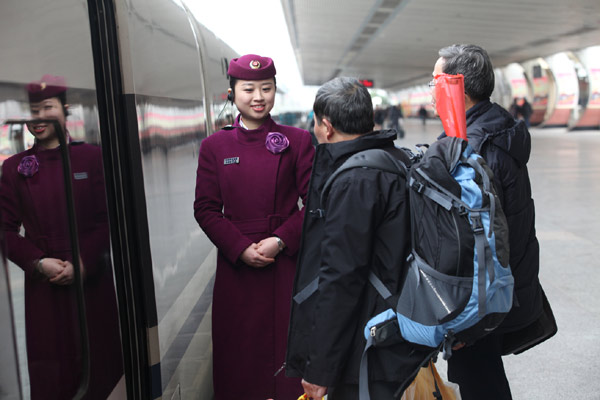 |
|
Travelers board a high-speed train in Guilin in the Guangxi Zhuang autonomous region. Guangxi became the country's first ethnic autonomous region to be integrated into the national high-speed railway network. Chen Fuping / for China Daily |
China Railway Corp put seven high-speed lines into service in southern, central and western China on Saturday. The national high-speed railway network, consisting of eight major lines - "four horizontal and four vertical" - has taken shape with the seven new lines.
China's high-speed railway now exceeds 10,000 kilometers - nearly half of the global total - and is expected to hit 18,000 km by 2020.
Shaanxi province's Xi'an-Baoji line runs at 250 km per hour. The other six are 200 kph. They are slower because they traverse trickier topography.
It took six years for construction workers and engineers to build these historic high-speed railways across the diverse and often-challenging landscapes. This time was spent grinding twisting terrain into smooth routes.
Travel time from Beijing to Guilin, a picturesque city in the Guangxi Zhuang autonomous region, has been shortened from about 26 hours to 10.5 hours. It now takes 3.5 hours to go from Guangdong province's Shenzhen to Fujian province's Xiamen by bullet train - eight hours fewer than before. And travel time from Shanghai to Shenzhen has been cut from 18 hours to fewer than 12.
The high-speed rail along the coastlines of Zhejiang, Fujian and Guangdong - connecting Shanghai, Xiamen and Shenzhen - is crucial to the integration of the three economic hubs: the Yangtze River Delta, the Fujian city clusters and the Pearl River Delta.
The number of passengers from Guangdong to North China has risen 20 percent this year, thanks to the 2,298-km Beijing-Guangzhou high-speed railway - the world's longest. It has carried nearly 100 million people its first year.
It is significant that four of the seven new lines are in Guangxi. Guangxi railway construction office deputy director Luo Wei said the high-speed railway network in Guangxi has extended over six years from nothing to 1,137 km - a 10th of the national total.
Guangxi, with 230,000 square kilometers and 50 million residents, is China's first ethnic autonomous region to be integrated into the national high-speed railway network before the Xinjiang Uygur, Ningxia Hui, Inner Mongolia and Tibet autonomous regions.
Analysts believe the high-speed railway is crucial for regional integration. Many ASEAN members have shown a strong interest in building high-speed railways.
Guangxi occupies an important position in China's trade and connection with the Association of Southeast Asian Nations. It is the only region in China linked to Southeast Asia by land, sea and air.
The high-speed railways connecting Guangxi and Hunan province were connected in Liuzhou in northern Guangxi in mid-December, integrating Guangxi's regional high-speed railways with the national high-speed network.
Nanning railway bureau's passenger-transport division director Xie Shi said the bureau will run 24 trains on the six lines in the early stage. That provides 17,000 seats a day. It will adjust the transport capacities according to market fluctuations.
The ticket price from Guilin to Beijing is 2,530 yuan ($415) for a business-class seat, 1,250 yuan for a first-class seat and 806 yuan for a second-class seat. The cost is comparable to flight prices.
Guilin's tourism agencies are optimistic about the new travelers the bullet train will bring from inland China.
Ticket prices for a high-speed train in the region range from 30 yuan to 150 yuan.
Some counties in Guangxi's economic hubs Guilin and Liuzhou boast their own high-speed railway stations.
Spokespeople for Guilin's Quanzhou county and Liuzhou's Luzhai county said that not only will the counties' commuters enjoy more convenient travel but also investors and travelers will more easily access these locations. Previously, county-level prefectures could be reached only by expressways.
liyang@chinadaily.com.cn